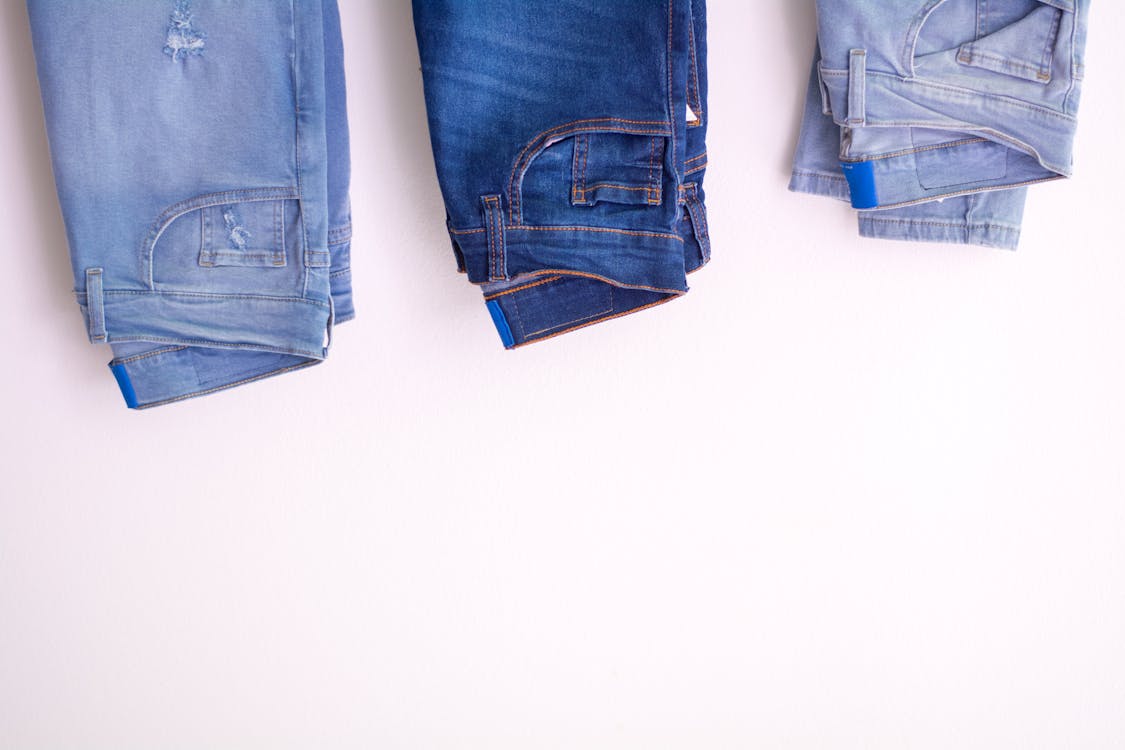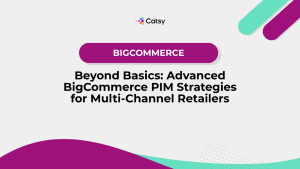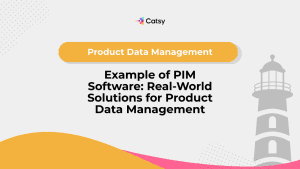Optimize Product Attribute Management and Maximize Your Sales Now

In this Article
Just as humans have different characteristics that make us unique, so do products. In eCommerce, product attributes offer the informative experience that only a 2D shopping experience can. With detailed information, product attributes and all of its types help sell an item. In this article, we’ll discuss the importance of attributes, the various attributes that exist, and most significantly, how to best optimize your product attributes for ultimate sales revenue.
What are product attributes?
Think of attributes as the features or properties that make your item what they are. Color, packaging, capacity, size, weight, and anything else that describes it.
Describing product attributes, marketing guru Philip Kotler said, “Product attributes are the ingredients necessary for performing the product or service function sought by consumers.”
In other words, when combined, attributes create a product that fulfills all of the wants and needs that a customer expects. When you bake a recipe that includes banana, cinnamon, and walnuts, it delivers the expectation of a banana bread that tastes exactly as it should – rich, cinnamony, and nutty. If you’ve ever had a dinner party, there will always be at least one person asking about the components in every dish. That person represents every consumer in the world.

Why Product Attributes Matter
Product attributes directly affect customer purchase decisions.
In short, product attributes matter because they inform the buyer extensively about the product. The more descriptive they are, the better they perform in terms of increasing buys. If customers see your products’ attributes as unique, they become the distinguishing factors setting your items apart from your competitors’. When these are seen as valuable, you convert lookers into buyers and make sales.
A lot of people like banana bread. But some prefer it with chocolate chips, while others prefer a vegan recipe. Similarly, a lot of similar products exist, with only their attributes differentiating them.
Interestingly, attributes and your target audience work together symbiotically. Sure, an item’s feature can hint at what sort of consumer will derive value from it. On the other side of the coin, your target customers give you an idea of what they want.
You need to know your target customers and their preferences to optimize attributes. Basically, how can you give them what they want for a price they can afford? The answer is, sell them a product ripe with the attributes they want.
Product Attributes: A Competitive Standpoint
Let’s talk about competition.
Other products in the market can largely affect how a consumer engages with them. So the way you present attributes has to invoke this relativity. In other words, attributes will describe an item in how it either compares with or contrasts against similar ones.
This means attributes will fall under one of two categories:
- Points of parity refer to how a given product or service has attributes that match those of competing.
- Points of difference refer to the opposite – how a product has attributes that differentiate it from the items and services of competing companies.
A product lacking points of parity can’t even boast of offering the same attributes as competing products, thus, is not likely to sell well. On the other hand, an item without any points of difference lacks uniqueness, and it might be just as unpopular.
Interestingly, in some cases, points of difference may gradually transform into points of parity over time. Meaning, if more companies in a niche gain inspiration from other competitors to stand out – well, then you’ve got a lot of products “standing out” in the same way. But that’s what makes eCommerce fun. Because there will always be new ideas and innovations for unique attributes.
Regardless, remarkable experiences delight customers and drive conversion.
Types of Product Attributes
The various features can be organized into different kinds of attributes.
- Tangible and intangible attributes
- Determinant attributes
- Dissatisfiers
- Vestigial and extinct features
- Aesthetics
Tangible vs. Intangible Product Attributes
You can divide attributes by their level of corporeality. In other words, some characteristics are more physical and easier to observe than others. Tangible attributes are so, as you can define, measure, see, taste, or smell them. Intangible attributes are more fluid in their definition, and hence difficult to define objectively.
Tangible Attributes
As physical properties that you can use your senses to experience, tangible attributes consist of the following.
- Size
- Color
- Feel
- Packaging
- Weight
- Taste
- Quantity
- Material composition
Intangible Attributes
The following attributes are characteristics that are more subjective in their description but are still important to customer satisfaction and inciting emotion.
- Quality
- Reliability
- Aesthetics
- Price
Both tangible and intangible attributes are critical for a well-rounded, complete painting. Focusing on one type more than the other can create a lot of holes in a buyer’s perception.

Consider the example of a car.
Qualities like the car’s color or the interior décor can determine which brand a customer might buy. On the other hand, safety tests or overall quality might prompt a customer to buy this or that brand. As you can see, both offer high value in informing a customer about what the item offers.
Hence why you must properly optimize your tangible and intangible attributes. After all, they are the criteria your customers use to make buying decisions.
Determinant Attributes
Before developing strategies to help manage your items, familiarize yourself with your products’ determinant attributes. The term determinant signifies the aspect or nature of something that will determine ultimately a customer’s decision to buy it. In that way, a determinant attribute highlights the underlying reason that someone buys an iten. It’s more than just the practical feature of it.
Take fast-food, for example.
Fast-food is quick, easy, and cheap, right? Digging deeper, customers may be drawn to service speed, interior décor, restaurant ambiance, or simply the courteous staff. In this case, fast food has the basic, obvious, superficial level of attributes that describe it. But the more resonant essence of fast-food and the experience of eating it is more likely to beckon customers.

Determinant attributes vary by customer. Just because you know you offer something you think is valuable, you need to be able to translate that value to your customers.
Use product ratings to communicate determinant attributes
Often, the easiest way to communicate the value of determinant attributes is with product ratings.
Even negative reviews are useful. After all, they convey which determinant attributes customers notice, enjoy, don’t know about, can do without, or outright don’t like.
Responding to bad reviews gives you the opportunity to build brand reputation, a critical intangible attribute.
Dissatisfiers
Marketers classify some types of attributes as dissatisfiers: attributes customers don’t like. As per the name, dissatisfiers are attributes that discourage customers from buying a given product or service.
Dissatisfiers can range from flaws in design to unappealing presentation. They may even include immaterial or polar affinities between the item, brand, company, and the customers’ preferences. In other words, the brand and the customer simply do not connect.
When you optimize attributes, dissatisfiers will be your first priority. At a minimum, it’s best to overhaul dissatisfiers to improve overall appeal. At worst, you may need to simply discontinue.
Vestigial and Extinct Features
Sometimes, companies might need to phase out certain attributes over time. Meaning, they might come to a point where discontinuing a product is better than keeping it on the market. Usually, this is due to vestigial and extinct features.
Vestigial or extinct features are attributes that no longer have a functional purpose to serve. More specifically, vestigial attributes may embody a different purpose.

For example, the initial purpose of the small second pocket inside the larger right-hand pocket of your Levi’s jeans was to hold your pocket watch. Obviously, most people stopped using pocket watches centuries ago. However, Levi’s still have a watch pocket simply because…people still like them. In this case, the attributes went from serving a practical purpose to an aesthetic purpose.
Extinct attributes are completely discontinued, hence the name. So if Levi’s had instead completely stopped adding a smaller pocket to their jeans, they would be extinct. The process by which attributes become vestigial or extinct is entirely up to context. The time period, current social climate, current cultural values, and fashion trends all influence and perpetuate certain attributes.
Thus, it’s vital to constantly reevaluate and optimize your product attributes. At a minimum, you must ensure that they satisfy your customers’ needs. Then, you can consider any nonessential elements, like the aesthetic design.
Determining how to optimize attributes is essential. Not only to delight your customers, but also give you a competitive edge. Today, searching often displays similar items side-by-side. So it’s easy for shoppers to be swayed by this product or the other.
How to Optimize Product Attributes
When it comes to product characteristics, complexity thrives. Optimizing them for digital platforms is not as simple as saying, “This is the item, and here are all of its features.” To gain an upper hand in ecommerce, it takes more effort and planning.
Fortunately, there are just as many solutions as there are areas to improve. Like anything else in marketing and selling, you can create a strategy to optimize your attributes to rack in more revenue.
What does it mean to optimize product attributes?
Simply, it’s consists of a strategy of improving and reiterating the quality of promoting attributes. It means managing product information in a way that pleases and informs. To optimize attributes is to delve into a fantastic relationship with customers. If you think about it, it’s how you hone in on what your product’s characteristics, features, and benefits offered to people’s lives.
That being said, here are the general steps to optimize your product attributes:
- Start with the positioning strategy
- Design
- Aesthetic appeal
- Quality improvement
- Presentation and packaging
Positioning Strategy
Before you begin any endeavor to promote attributes, it’s best to establish your positioning. Simply, a positioning strategy is your company’s objective. It’s when you pick a key focus of how you want to position your item or brand image – how you want buyers to perceive it.
Your positioning will help customers answer the question, “Why should I buy this brand?” A well-thought strategy determines the value proposition of your products. In other words, it is the promise you make to your potential customers, which inspires them to buy your product. The most important concern to remember here is to never make promises you can’t keep.
With this in mind, your company can utilize any of the multiple positioning strategies. These tend to vary by company, product, and target market, directly affecting success.
- Sell lower quality items at a significant discount
- Charge customers less than your competitors do for the same
- Sell something that outperforms your competitors’ products at a lower price
- Charge customers what your competitors charge, but provide better alternative
- Sell a premium product at a premium price
Companies gravitate toward or shy away from these positioning strategies according to the implication they can have on the overall brand image.
Depending on how these positioning strategies impact overall brand image, you can choose to gravitate towards or shy away from them.
Do you want your company to exude an image of customer-pleasing affordable prices? Or do you want to take on the impression of luxury? Do you want recognition for giving the product worth its price, no matter how high?
As the bridge between your customers and your products, you must embed your positioning in both
Optimize Product Attributes with the Initial Product Design

Distinctive, unique product design often adds a great deal of customer value.
People want to buy something they consider cutting edge, intriguing, cool. They want something that showcase exquisite, even daring, design. But simply having an explosive, new idea isn’t enough.
You need to conduct research into your customers to figure out what they want, need, and expect. Doing this will allow you to create a design that suits your item according to the specifics of your target customers.
A winning strategy might focus on unique design features, using them to your competitive advantage.
Research first, and stand out within reason
On the other hand, customers might be so used to the standard specifics that overhauling the design could result in fewer sales. While it might seem like a guessing game, research will reveal the specific data you need to understand to delight your customers with products that solve their problems.
If your research indicates focusing on design is the correct decision, you might choose to redesign your existing items.
This new design obviously should captivate customers enough to elicit a second, third, and even fourth look. Product design rests on customer demand for an ever-greater variety of products doing basically the same thing.
So much of online shopping is the search for something to replace another product that doesn’t quite do what the customer thought it would do. Design versus functionality is a delicate balance, which directly affects the product lifecycle.
Know where your product is in its lifecycle.
The product lifecycle is the life-and-death system that a product undergoes from conception to decline. Being cognizant of your product’s place in the cycle ensures you’re not wasting your effort. Meaning, if your item is already in the maturity stage – wherein you’re beginning to receive sales – you must be prepared to address issues in a rapid-fire way.
For example, is it declining in sales? If so, you must know whether you should improve the superficial concerns, like packaging, or more important concerns, like design, or crucial concerns of functionality. Because the maturity stage is potentially the most profitable, it’s crucial to pinpoint the problem immediately.
Now, if it is still in the introduction stage, in which your target audience is just hearing about it, pay attention to the reaction. Are people responding positively to your marketing? What are their expectations? In turn, this information can back up your development and improvement strategy.
Remember, it’s pretty difficult to sell anything without knowing where your products are missing the mark. Learn what and where the issue is, and you can find a solution. Not only can you create a stunning product, but also propel sales that mirror its magnificence
Managing Product Aesthetic Appeal
When you hear the word aesthetics, words like beauty, attractiveness, and pleasurable come to mind.
Product aesthetics, which appeal both to the five senses and emotions, are critical to consider when designing products. Aesthetic appeal can even be the primary selling point for some items, while for others the opposite is true. This tends to vary both by item and target customer.
Successful companies understand the importance of visual elements in influencing buying choices.
Ask yourself, “How can I make my products look more beautiful?” The answer to this question could be found in anywhere from initial functionality and design, to the images you use in online sales.
Companies ignore individual steps in this process to their utter detriment. Even beautiful items can display a poor presentation online, while less attractive ones can arrive in appealing packaging that inspires more sales. Today, many tools like DAM help create compelling product pages that employ diverse digital assets that showcase the aesthetic appeal of your products
Ensure Quality to Optimize Product Attributes
Product quality is a feature or set of features that reliably solve the problem the customer bought it to solve. But quality is more than just about the product. Rather, quality is the whole experience.
Individual wants and needs tend to vary from customer to customer. Because this variability had a direct effect on a given customer’s concept of quality, it tends to be subjective. This is especially true when selling any item capable of fulfilling more than one customer need.
Why do your customers like your products?
Do your customers like your products because they look good? Because they’re cheap or durable? Is it because they solve a very specific problem well? Or is it any combination of these? If customers find quality in an area that’s completely distinct from your main goal, consider revising something about either your product or your positioning strategy.
But that’s okay. Because this is what quality assurance is all about. Like we mentioned before, creating a successful product requires a back-and-forth between customer response and your objectives. Understanding what exactly it actually delivers, compared to your initial goals, is incredibly informative.
Focus on the experience
In ecommerce, quality begins with the experience each customer has on your website. It encompasses the journey from delivery and unboxing, to every time they use it.
Begin cultivating a mindset that focuses on quality by asking, “Is my processes organization good enough?”
Remember, standardization and consistency maximize efficiency. Standardization means imposing guidelines that make every piece of the process adhere to your desired level of quality. Additionally, making your company’s quality standards consistent across all facets paves the way to a strong brand image.
What does this entail? Begin with recruiting and training your personnel according to your desired standards. Continue by defining work goals and processes sufficiently. And finally, really center on clear, open communication both within your operation and between the company and customers.
Progress is progress
Communication is key to observing how you are doing. Any increase in customer satisfaction is an indication you are doing something right.
Build on these by obtaining feedback from suppliers, partners, and employees alike to further improve practices. Such feedback highlights areas of weakness while magnifying those of strength. Both of these, you can leverage to build a highly productive and profitable organization, meeting the quality standards of all parties.
Product Presentation is the Silent Salesman

A product attribute doesn’t have to be the finer details. It could also be something broad and encompassing, like presentation. Referring to anything from how you display your items online to how they reach your customers, the presentation can mean a lot of things.
Product presentation is an easy attribute to ignore or forget. But having to optimize attributes will require you to pay attention to every possible detail. For example, let’s say you’re already selling the best solution in a demand-heavy market. However, for some reason, sales are low. If you’re doing everything right, you think, why could this be?
The problem could be your packaging or unboxing experience – presentation.
Ecommerce is a visual experience
Your packaging needs to drive intrigue and your unboxing experience has to balance excitement against tedium.
Truthfully, instinct buying is growing, because ecommerce is a primarily visual experience. Even before the logical side of the brain has time to weigh the decision, it’s over. The item with the most attractive presentation flies off the shelf. So put yourself in the shoes of a customer making somewhat impulsive decisions. This understanding can inform your presentation choices.
Apply sensory triggers to your packaging design
When designing your packaging, apply sensory triggers to generate the subconscious emotional responses that drive expectations and excitement.
What are sensory triggers? They are any physical stimulus that speaks to all the senses, prompting a strong emotional response. It is when the unboxing process becomes a pleasurable experience – when the colors, textures, smells all delight.
All the sensory triggers you add to your packaging design must align with your brand. Customers should be able to tell what they are receiving with only a glance – not only regarding the product but what your company’s image promises. And of course, your packaging must be just unique enough in its sensory experience to tantalize your customers.

How do you design your packaging for a great experience?
Packaging has to do more than just adequately protect your products from any damage that may occur during delivery. The number of bad reviews that result from poor packaging might surprise you.
To maximize this area of potential, you’ll have to be more creative in designing the packaging.
- Choose packaging material that fully encompasses what your company stands for. For example, a sustainable company might want to use recyclable, zero-waste packaging.
- Use pleasant colors that make sense with your brand.
- Ensure ease and clarity of how to open the package.
- Lay it within the packaging creatively.
- Choose fillers wisely – be it tissue paper, bubble wrap, or peanuts.
- Include extra surprises inside, like a personable note, printed content, or some free samples.
Subsequently, these decisions improve popularity by encouraging positive reviews.
Don’t forget the emotional response
Never underestimate the power emotions have over purchase decisions.
When companies work hard to provoke customers’ feelings, there is a significant effect on buying activity. Do this with how you present your items, both online and delivered. Both the product page and packaging should mirror this strategy.
Incite emotional engagement with your customers in order to be more memorable. Optimize attributes to reel customers in by their potential value. Furthermore, build on the value of these attributes by enhancing your product’s image when it arrives at customers’ doors. Doing so will boost the experience of quality, aesthetics, and drive home the idea that it exceeds expectations every step of the way.
Presentation is the silent salesman at work. A PIM tool can help you take advantage of that, and other aspects important to managing your product attributes.
Product information management (PIM) is a catalog software tool built to speed products to market.
Digital asset management (DAM) is a software used to organize and enrich digital assets.




